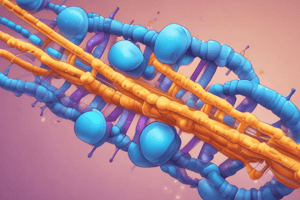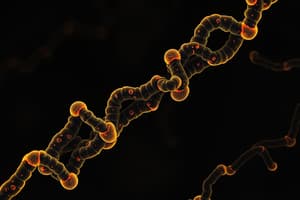Podcast
Questions and Answers
What is the name for the fundamental unit of chromatin in the packaging of DNA within a human chromosome?
What is the name for the fundamental unit of chromatin in the packaging of DNA within a human chromosome?
Nucleosome
What is the name given to the structure that results from the packaging of DNA with core histones?
What is the name given to the structure that results from the packaging of DNA with core histones?
Nucleosome
What is the name of the protein complex that interacts with a heterogeneous group of nonhistone proteins, which are involved in establishing a proper spatial behavior and appropriate gene expression?
What is the name of the protein complex that interacts with a heterogeneous group of nonhistone proteins, which are involved in establishing a proper spatial behavior and appropriate gene expression?
Histones
What is the name of the histone core structure that is organized around a segment of DNA, which is approximately 140 base pairs (bp) in length?
What is the name of the histone core structure that is organized around a segment of DNA, which is approximately 140 base pairs (bp) in length?
What is the name of the structure formed by the coiling of nucleosome fibers?
What is the name of the structure formed by the coiling of nucleosome fibers?
What is the name of the complex of DNA, which is further condensed beyond the solenoid level, resulting in a structure that is nearly 100 times shorter than the original DNA chain?
What is the name of the complex of DNA, which is further condensed beyond the solenoid level, resulting in a structure that is nearly 100 times shorter than the original DNA chain?
Chromosomes are visible as distinct structures only in dividing cells.
Chromosomes are visible as distinct structures only in dividing cells.
Chromatin is a relatively homogeneous substance and appears nearly the same in all parts of a cell.
Chromatin is a relatively homogeneous substance and appears nearly the same in all parts of a cell.
The DNA molecule in the human nucleus is organized into separate, distinct chromosomes.
The DNA molecule in the human nucleus is organized into separate, distinct chromosomes.
The structure of the human chromosome varies with the stage of the cell cycle.
The structure of the human chromosome varies with the stage of the cell cycle.
The packaging of DNA into chromosomes is a vital process that ensures efficient replication and segregation of each chromosome into daughter cells during cell division.
The packaging of DNA into chromosomes is a vital process that ensures efficient replication and segregation of each chromosome into daughter cells during cell division.
The structure of chromosomes is maintained by specialized proteins, which bind to DNA to form nucleosomes.
The structure of chromosomes is maintained by specialized proteins, which bind to DNA to form nucleosomes.
The number of chromosomes within a given cell is constant throughout the organism's lifespan.
The number of chromosomes within a given cell is constant throughout the organism's lifespan.
The packaging of DNA into a nucleosome involves the wrapping of DNA around a histone octamer, which consists of eight histone molecules.
The packaging of DNA into a nucleosome involves the wrapping of DNA around a histone octamer, which consists of eight histone molecules.
Chromatin is only present in the nucleus of a cell.
Chromatin is only present in the nucleus of a cell.
Flashcards
Chromatin
Chromatin
A complex of DNA and proteins that packages DNA into a compact structure within the nucleus.
Nucleosome
Nucleosome
The fundamental structural unit of chromatin; DNA wrapped around a core of histone proteins.
Histone
Histone
Proteins that help package DNA into chromatin.
Chromosome
Chromosome
Signup and view all the flashcards
Double Helix
Double Helix
Signup and view all the flashcards
Gene
Gene
Signup and view all the flashcards
Nucleotide
Nucleotide
Signup and view all the flashcards
Adenine (A)
Adenine (A)
Signup and view all the flashcards
Thymine (T)
Thymine (T)
Signup and view all the flashcards
Guanine (G)
Guanine (G)
Signup and view all the flashcards
Cytosine (C)
Cytosine (C)
Signup and view all the flashcards
Study Notes
Chromosome Structure
- A chromosome is a single, continuous DNA double helix
- DNA and proteins make up the chromosome material, called chromatin
- Within each cell, DNA is complexed with proteins to form chromatin
- Chromosomes are not naked pairs (double helices)
- There are 6 billion nucleotide pairs, totaling more than 6 billion base pairs in the human genome
- Several classes of specialized proteins
- Chromatin is highly organized
- Chromatin exists in different levels of structure
- A string called a nucleosome, the basic structural unit of chromatin
- Nucleosomes are beads of DNA, with histones (proteins)
- The nucleosomes make a solenoid
- The solenoid coils to form a 30-nm fiber
- The 30-nm fiber coils further to form chromatin fibers, and eventually a chromosome
- Chromatin is highly organized to allow DNA to fit into the nucleus, during cell division the level of packaging increases
- Various levels of chromatin packaging are shown in Figure 2-5
Studying That Suits You
Use AI to generate personalized quizzes and flashcards to suit your learning preferences.



